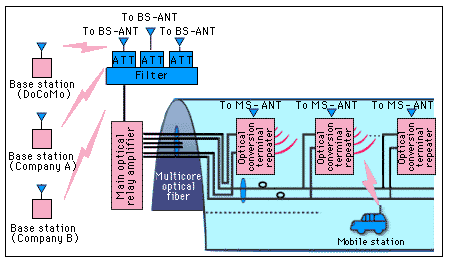Antennas, Base and Mobile Stations -6.Measures for Dead Sections and Transmission Power Control
In order to provide good-quality service in locations where radio waves cannot easily reach, such as inside tunnels and underground shopping centers, the radio waves from base stations and mobile stations must be amplified and relayed to such sites. This process uses an amplifier to convert the radio signals to optical signals, which are then transmitted by optical fiber installed within the dead section. The optical signals are converted back to radio signals at each repeater, and the radio waves are then emitted from the antenna. This enables the transmission of broadband frequencies, making it possible to realize stable quality within a tunnel even in case of 1.5-GHz service -- something that was difficult in the past.
Additionally, the base station measures the level of signals transmitted by a mobile terminal during a call and issues instructions to the mobile terminal by using control signals during the call to prevent the terminal from outputting more transmission power than necessary. Conversely, the mobile terminal also originates and transmits similar control signals to the base station. This technology to control transmission power is called adaptation transmission power control, which is effective in reducing the power consumed by the mobile terminal and base station, as well as in reducing the interference experienced by other base stations and mobile terminals.

Blind Area Solution Using Optical Transmission
![]() Created 1999/03
Created 1999/03
